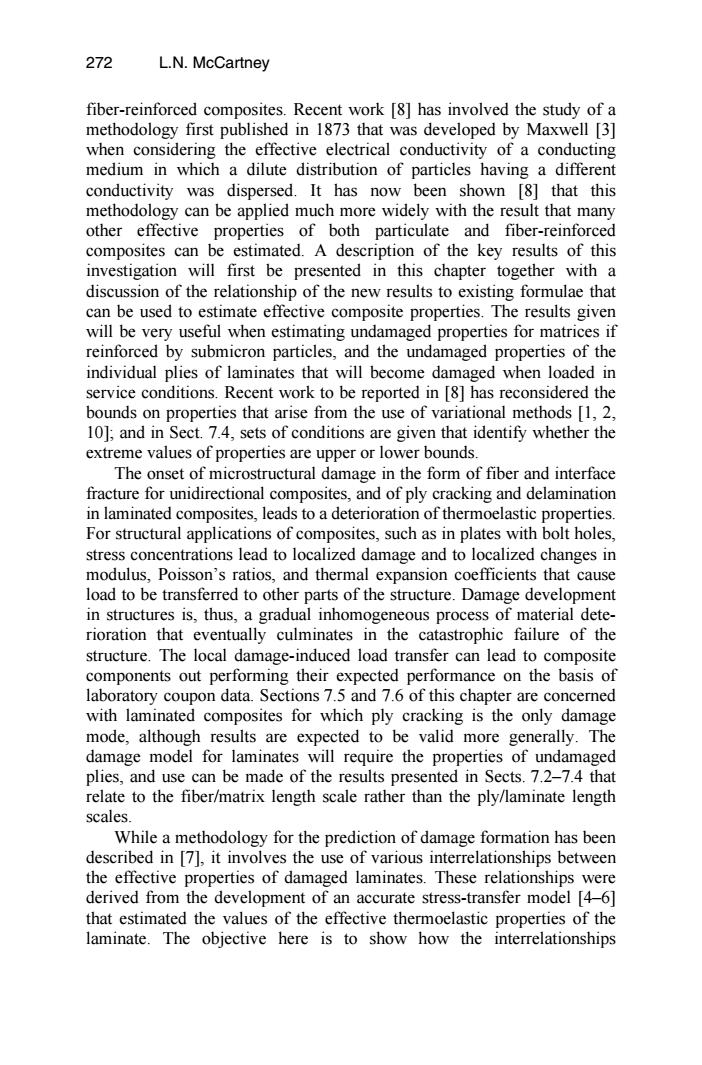正在加载图片...

272 L.N.McCartney fiber-reinforced composites.Recent work [8]has involved the study of a methodology first published in 1873 that was developed by Maxwell [3] when considering the effective electrical conductivity of a conducting medium in which a dilute distribution of particles having a different conductivity was dispersed.It has now been shown [8]that this methodology can be applied much more widely with the result that many other effective properties of both particulate and fiber-reinforced composites can be estimated.A description of the key results of this investigation will first be presented in this chapter together with a discussion of the relationship of the new results to existing formulae that can be used to estimate effective composite properties.The results given will be very useful when estimating undamaged properties for matrices if reinforced by submicron particles,and the undamaged properties of the individual plies of laminates that will become damaged when loaded in service conditions.Recent work to be reported in [8]has reconsidered the bounds on properties that arise from the use of variational methods [1,2, 10];and in Sect.7.4,sets of conditions are given that identify whether the extreme values of properties are upper or lower bounds. The onset of microstructural damage in the form of fiber and interface fracture for unidirectional composites,and of ply cracking and delamination in laminated composites,leads to a deterioration of thermoelastic properties. For structural applications of composites,such as in plates with bolt holes, stress concentrations lead to localized damage and to localized changes in modulus,Poisson's ratios,and thermal expansion coefficients that cause load to be transferred to other parts of the structure.Damage development in structures is,thus,a gradual inhomogeneous process of material dete- rioration that eventually culminates in the catastrophic failure of the structure.The local damage-induced load transfer can lead to composite components out performing their expected performance on the basis of laboratory coupon data.Sections 7.5 and 7.6 of this chapter are concerned with laminated composites for which ply cracking is the only damage mode,although results are expected to be valid more generally.The damage model for laminates will require the properties of undamaged plies,and use can be made of the results presented in Sects.7.2-7.4 that relate to the fiber/matrix length scale rather than the ply/laminate length scales. While a methodology for the prediction of damage formation has been described in [7],it involves the use of various interrelationships between the effective properties of damaged laminates.These relationships were derived from the development of an accurate stress-transfer model [4-6] that estimated the values of the effective thermoelastic properties of the laminate.The objective here is to show how the interrelationshipsfiber-reinforced composites. Recent work [8] has involved the study of a methodology first published in 1873 that was developed by Maxwell [3] when considering the effective electrical conductivity of a conducting medium in which a dilute distribution of particles having a different methodology can be applied much more widely with the result that many other effective properties of both particulate and fiber-reinforced composites can be estimated. A description of the key results of this investigation will first be presented in this chapter together with a discussion of the relationship of the new results to existing formulae that can be used to estimate effective composite properties. The results given will be very useful when estimating undamaged properties for matrices if individual plies of laminates that will become damaged when loaded in service conditions. Recent work to be reported in [8] has reconsidered the bounds on properties that arise from the use of variational methods [1, 2, 10]; and in Sect. 7.4, sets of conditions are given that identify whether the extreme values of properties are upper or lower bounds. The onset of microstructural damage in the form of fiber and interface fracture for unidirectional composites, and of ply cracking and delamination in laminated composites, leads to a deterioration of thermoelastic properties. For structural applications of composites, such as in plates with bolt holes, stress concentrations lead to localized damage and to localized changes in modulus, Poisson’s ratios, and thermal expansion coefficients that cause load to be transferred to other parts of the structure. Damage development in structures is, thus, a gradual inhomogeneous process of material deterioration that eventually culminates in the catastrophic failure of the structure. The local damage-induced load transfer can lead to composite components out performing their expected performance on the basis of laboratory coupon data. Sections 7.5 and 7.6 of this chapter are concerned with laminated composites for which ply cracking is the only damage mode, although results are expected to be valid more generally. The damage model for laminates will require the properties of undamaged plies, and use can be made of the results presented in Sects. 7.2–7.4 that relate to the fiber/matrix length scale rather than the ply/laminate length scales. While a methodology for the prediction of damage formation has been described in [7], it involves the use of various interrelationships between the effective properties of damaged laminates. These relationships were derived from the development of an accurate stress-transfer model [4–6] that estimated the values of the effective thermoelastic properties of the laminate. The objective here is to show how the interrelationships L.N. McCartney reinforced by submicron particles, and the undamaged properties of the conductivity was dispersed. It has now been shown [8] that this 272